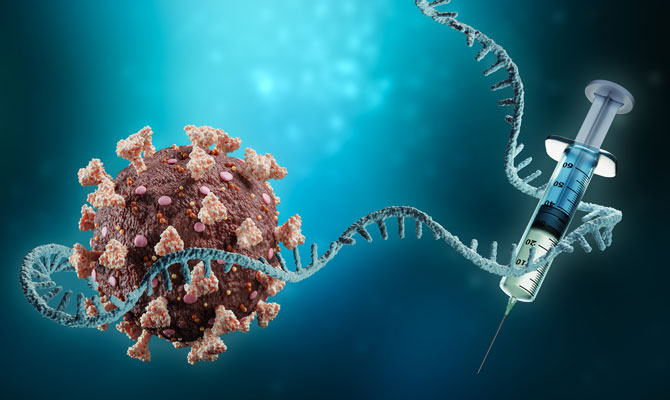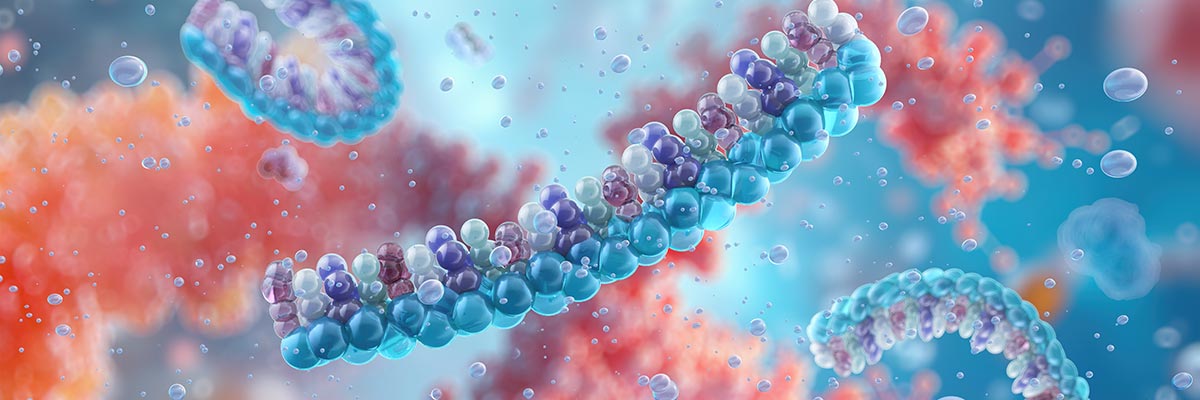
microRNA – a small RNA with a big impact
The Nobel Prize in Physiology or Medicine 2024
Since their discovery in 1993, microRNAs have been the subject of intensive research due to their fundamental role in gene regulation and are considered promising therapeutic options for the future. In our article, you can find out why they earned those that discovered them the Nobel Prize in Physiology or Medicine in 2024 and what makes these tiny RNA molecules so special.
What makes us human beings?
Our spirit, our body, our intelligence or our feelings? There’s no simple answer – a philosopher will answer this question differently than a theologian, and both will answer differently than a scientist.
A molecular biologist will surely answer – our DNA. Stored in our genetic code, it contains all the information needed to control every process in our body as the “blueprint of life”. The fertilised egg cell is already equipped with this “complete package” of genetic information and passes it on to all the body’s cells. But although these cells are genetically identical, they develop very differently during the development of the embryo – into skin, blood or brain cells, into cells of our heart, liver and kidneys, they form tendons, muscles and bones.
How can this be? How can our body form so many different cells and tissues even though all cells contain identical DNA?
The answer to this question is likewise not simple, but it is at least clear – through gene regulation. Put simply, this means that not all genes are permanently active in every cell of our body. Depending on the cell type, only certain genes are expressed, i.e. “translated” into the respective proteins for which they form the template (matrix). Genes for other proteins not needed in this cell are, on the other hand, silenced.
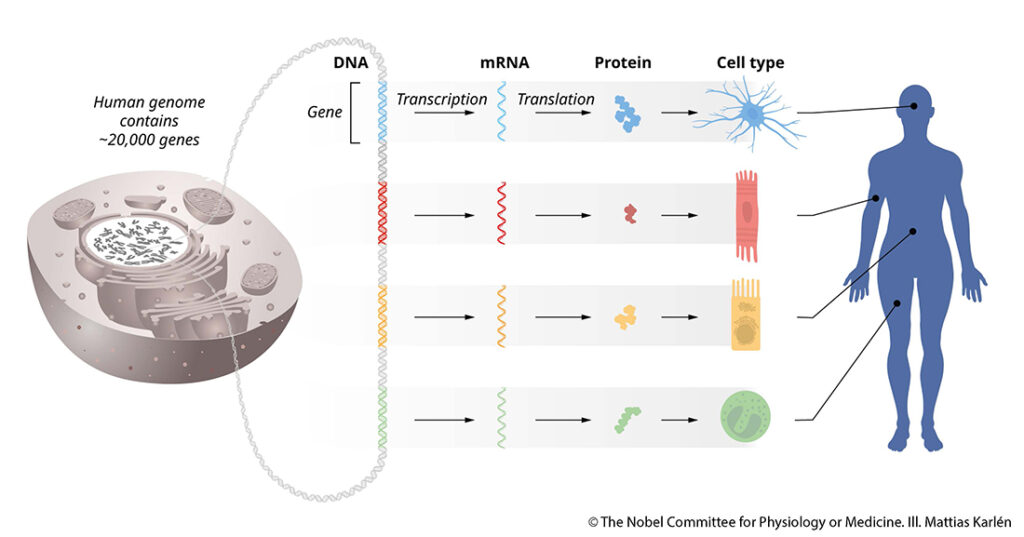
It can be compared to an office with lots of rooms, in which the same cabinet with the same large number of files in lots of drawers is always present. If you open all the drawers and try to implement all the instructions, the result is utter chaos. Therefore, most drawers in each room remain closed, and only a few are marked “Please open and implement” – a specially defined set in each room. Only those drawers (genes) that are truly relevant to that room (cell) are opened and the instructions implemented (proteins produced).
Without this regulation of active or inactive genes, i.e. the prevention of “data reading” at the very beginning of the process, there would be chaos in the cells.
Small RNAs with a big impact
The gene regulation in every cell is by far the most fundamental and complex regulatory process in life. For clarifying the role of a group of key players in this process, American researchers Victor Ambros and Gary Ruvkun were awarded the Nobel Prize in Physiology or Medicine at the end of 2024.
What did they discover? Since the 1960s, transcription factors – proteins that attach themselves to genetic material and regulate transcription, i.e. the reading of certain genes – have been known to play an important role in gene regulation. However, not all gene regulatory processes could be explained in this way. There had to be additional regulatory mechanisms that came into play afterwards. In other words, post-transcriptionally, when the genes had already been “transcribed” into mRNA (messenger RNA), which serves as a matrix for protein expression.
With the discovery of the microRNA, in 1993, Ambros and Ruvkun found a completely new form of post-transcriptional gene regulation – initially in nematodes. These were small, non-coding RNA fragments, most of which were only 21 to 23 nucleotides long. Thanks to their base sequence, microRNAs can dock onto several different mRNAs and thus regulate the production of many proteins simultaneously. Conversely, the production of a protein can be blocked by several different microRNAs.
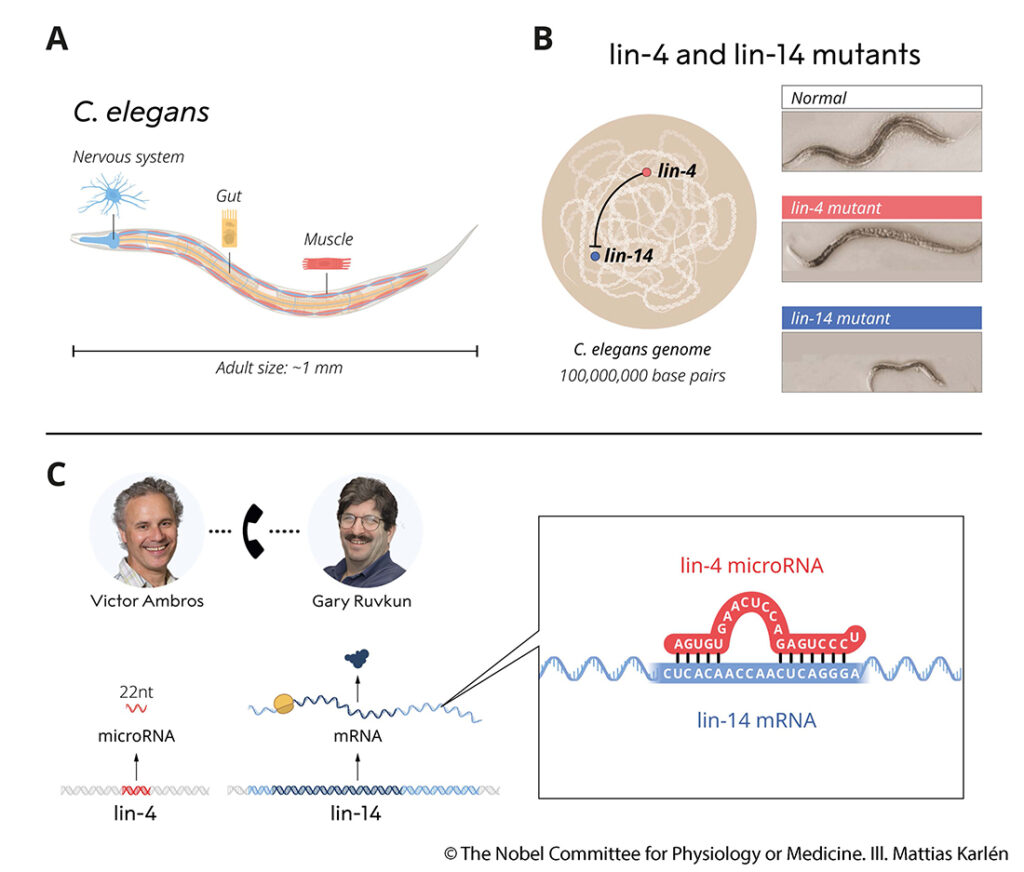
The small RNA sequences block the gene activity by attaching themselves to the 3’-untranslated regions of mRNA. This is the start of the mRNA, which is not translated into protein chains, but serves such regulatory processes. It is assumed that microRNAs mark the bound mRNA for the cell’s RNA degradation machinery and thus promote its targeted degradation. Among other things, this machinery ensures that excess, damaged or no longer needed RNA is broken down, thereby regulating the functionality and quantity of synthesised proteins. RNA from viruses or other pathogens is also broken down in this way, which helps protect against infections.
The process regulated by microRNAs is both efficient and finely adjustable. And it plays a crucial role in enabling so many different types of cells and tissues to develop from the same genetic material. “This groundbreaking discovery by Ambros and Ruvkun was unexpected and revealed a whole new dimension of gene regulation that is essential for all life forms,” explains the Nobel Prize Committee.
From basic knowledge to therapeutic application
Today, we know that our genetic material contains thousands of genes for such regulatory microRNAs and that its role is fundamental far beyond cell differentiation. “The regulatory role of the microRNA includes the timing of embryonic development, the origin and stability of cell lines, physiology and homeostatic balance,” explains the Nobel Prize Committee. MicroRNAs influence our inner clock, for example, and their existence appears to be closely linked to the evolution of increasingly complex organisms. From metabolic disorders to heart failure and psychological illnesses, microRNAs have been proven or are likely to be involved in a whole range of diseases. And since processes that are subject to complex regulation can also get out of hand, it’s hardly surprising that microRNAs may also be involved in the degeneration of cells and the development of cancer.
Understanding the function of microRNAs and the mechanisms associated with them therefore not only provides important basic knowledge. MicroRNAs are also of huge therapeutic importance – as active substances, as targets for new therapies or in the context of diagnostics. Since their discovery, they have been the subject of intensive research in this regard, and several candidates are already in the pipeline for practical application, whether as a treatment option for heart failure or for the early detection of Alzheimer’s disease.
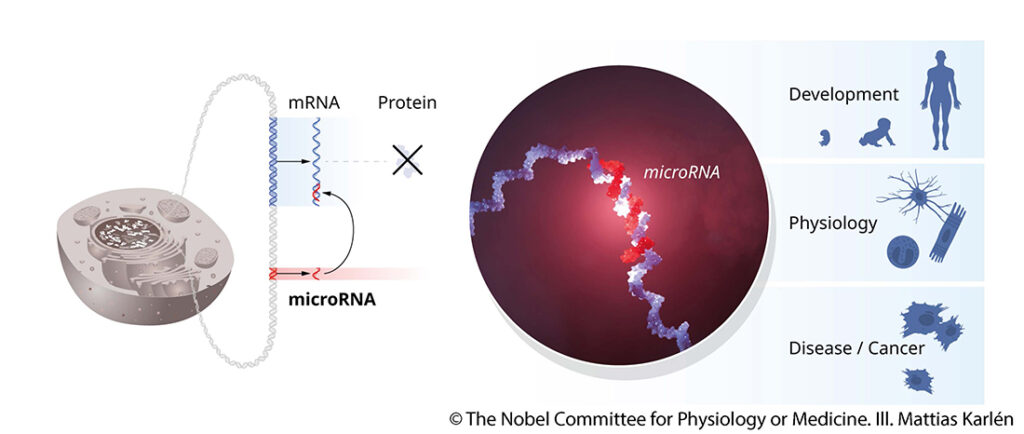
So what makes us human beings?
Every human is genetically unique – in fact the same applies for every animal, every plant and probably every micro-organism. But humans can use all their intellect in research to further explore the mechanisms of life, so that this knowledge can ideally benefit life. The example of microRNAs shows this once again.
Sources:
Nobelpreise 2024: Medizin-Nobelpreis für Rollenklärung der microRNA
Pressemitteilung: Nobelpreis für Physiologie oder Medizin 2024 – NobelPrize.org
MicroRNAs – mächtige Winzlinge, die Gene ausschalten
Erste microRNA-Therapie für das Herz funktioniert beim Menschen
Einblicke in die mRNA-abbauende Maschinerie der Zelle
Pictures:
Pressemitteilung: Nobelpreis für Physiologie oder Medizin 2024 – NobelPrize.org
The illustrations are free to use for non-commercial purposes.
© The Nobel Committee for Physiology or Medicine. Ill. Mattias Karlén


